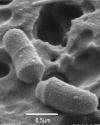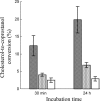Bacteroides sp. strain D8, the first cholesterol-reducing bacterium isolated from human feces
- PMID: 17616613
- PMCID: PMC2074900
- DOI: 10.1128/AEM.02806-06
Bacteroides sp. strain D8, the first cholesterol-reducing bacterium isolated from human feces
Abstract
The microbial community in the human colon contains bacteria that reduce cholesterol to coprostanol, but the species responsible for this conversion are still unknown. We describe here the first isolation and characterization of a cholesterol-reducing bacterium of human intestinal origin. Strain D8 was isolated from a 10(-8) dilution of a fresh stool sample provided by a senior male volunteer with a high capacity to reduce luminal cholesterol to coprostanol. Cholesterol-to-coprostanol conversion by strain D8 started on the third day, while cells were in stationary phase, and was almost complete after 7 days. Intermediate products (4-cholesten-3-one and coprostanone) were occasionally observed, suggesting an indirect pathway for cholesterol-to-coprostanol conversion. Resting-cell assays showed that strain D8 could reduce 1.5 mumol of cholesterol/mg bacterial protein/h. Strain D8 was a gram-negative, non-spore-forming, rod-shaped organism identified as a member of the genus Bacteroides closely related to Bacteroides vulgatus, based on its morphological and biochemical characteristics. The 16S rRNA gene sequence of strain D8 was most similar (>99.5%) to those of two isolates of the recently described species Bacteroides dorei. Phylogenetic tree construction confirmed that Bacteroides sp. strain D8 clustered within an independent clade together with these B. dorei strains. Nevertheless, no cholesterol-reducing activity could be detected in cultures of the B. dorei type strain. Based on Bacteroides group-specific PCR-temporal temperature gradient gel electrophoresis, there was no correlation between the presence of a band comigrating with the band of Bacteroides sp. strain D8 and cholesterol conversion in 11 human fecal samples, indicating that this strain is unlikely to be mainly responsible for cholesterol conversion in the human population.
Figures






References
-
- Bakir, M. A., M. Kitahara, M. Sakamoto, M. Matsumoto, and Y. Benno. 2006. Bacteroides intestinalis sp. nov., isolated from human faeces. Int. J. Syst. Evol. Microbiol. 56:151-154. - PubMed
-
- Bakir, M. A., M. Kitahara, M. Sakamoto, M. Matsumoto, and Y. Benno. 2006. Bacteroides finegoldii sp. nov., isolated from human faeces. Int. J. Syst. Evol. Microbiol. 56:931-935. - PubMed
-
- Bakir, M. A., M. Sakamoto, M. Kitahara, M. Matsumoto, and Y. Benno. 2006. Bacteroides dorei sp. nov., isolated from human faeces. Int. J. Syst. Evol. Microbiol. 56:1639-1643. - PubMed
-
- Björkhem, I., and J. Gustafsson. 1971. Mechanism of microbial transformation of cholesterol into coprostanol. Eur. J. Biochem. 21:428-432. - PubMed
-
- Bligh, E. G., and W. J. Dyer. 1959. A rapid method of total lipid extraction and purification. Can. J. Biochem. Physiol. 37:911-917. - PubMed
MeSH terms
Substances
Associated data
- Actions
LinkOut - more resources
Full Text Sources
Other Literature Sources
Medical
Molecular Biology Databases

